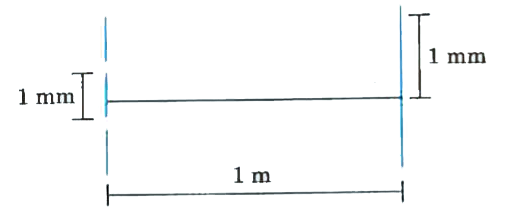Two slits are made on an opaque surface at a separation of 1 mm from each other. A screen is placed at a distance 1 m from the plane of the slits. A small hole is made on the screen at a distance 1 mm from the centre of the screen as shown in the figure. If we observe the light coming out from hole on the other side, then which wavelengths in the visible region will be absent and which will show strong presence ? Wavelength of visible light ranges from 400 nm to 700 nm.

Path difference between two waves from slits reaching the hole can be written as follows :
Δx=ydD=1×10−3×1×10−31=10−6
(A) Wavelengths interfering destructively at the location of hole will be absent from light coming out from hole.
Destructive interference ⇒Δx=(2n+1)λ/2.
(2n+1)λ2=10−6
By substituting minimum and maximum wavelengths of visible region in the above relation, we get corresponding maximum and minimum values of n and then we can find integers in this range of values.
⇒(2nmin+1)×700×10−9=2×10−6
⇒2nmin+1=2.86
⇒2nmin=1.86
⇒nmin=0.93
Similarly we can proceed to get nmax
⇒(2nmax+1)×400×10−9=2×10−6
⇒(2nmax+1)=5
⇒nmax=2 ......(1)
Integers in the above-calculated range are n=1 and 2, corresponding wavelenghts can be calculated by substituting back in the same relation.
(2n+1)λ=2×10−6⇒(2×1+1)λ1=2×10−6⇒λ1=667nm
(2n+1)λ=2×10−6⇒(2×2+1)λ2=2×10−6⇒λ2=400nm
The above-calculated two wavelengths will be absent from light coming out from the hole.
(B) Wavelengths interfering constructively at the location of the hole will be present strongly in the light coming out from the hole.
Constructive interference, Δx=nλ
nλ=10−6 ....(1)
By substituting minimum and maximum wavelengths of visible region in the above relation, we get corresponding maximum and minimum values of n and then we can find intergers in this range of values.
⇒nmin×700×10−9=1×10−6
⇒nmin=1.43
Similarly we can proceed to get nmax
⇒nmax×400×10−9=1×10−6
⇒nmax=2.5
Only integer in the above calculated range is 2 and corresponding wavelength can be calculated by substituting back in the same relation.
nλ=10−6⇒2λ=10−6⇒λ=−500nm
Hence 500 nm wavelength will be strongly present in the light coming out from hole.
Topper's Solved these Questions
- BOOK - MODERN PUBLICATIONCHAPTER - WAVE OPTICALEXERCISE - NCERT FILE SOLVED (TEXT BOOK EXERCISES)10videos
WAVE OPTICAL
- BOOK - MODERN PUBLICATIONCHAPTER - WAVE OPTICALEXERCISE - NCERT FILE SOLVED (Additional Exercises)11videos
WAVE OPTICAL
- BOOK - MODERN PUBLICATIONCHAPTER - WAVE OPTICALEXERCISE - Conceptual Questions23videos
WAVE OPTICAL
- BOOK - MODERN PUBLICATIONCHAPTER - SEMICONDUCTOR ELECTRONICS METERIALS DEVICES AND SIMPLE CIRCUITS EXERCISE - CHAPTER PRACTICE TEST FOR BOARD EXAMINATION12videos
SEMICONDUCTOR ELECTRONICS METERIALS DEVICES AND SIMPLE CIRCUITS
Similar Questions
Two slits are made on an opaque surface at a separation of 1mm beetween them. A screen in placed at a distance of 1m from the plane of slits. Find the separation between two consecutive maxima. Wavelength of light being used in the experiment is 500 nm.
View SolutionA Franhoffer diffraction pattern due to a single slit of width 0.2 mm is being obtained on a screen placed at a distance of 2 m from the slit. The first minima lie at 5mm in either side of the centre maximum on the screen. Find the wavelength of the light used .
View Solution
Knowledge Check
- Question 1 - Select One or More
In Young' s double-slit experiment, separation between the two slits is d and separation between plane of the slits and the screen is D. A small hole is made on the screen at a point directly in front of one of the slit. Some wavelengths are missing from the light coming out from hole on the other side. These wavelengths are
Ad2DBd22DCd23DDd24D - Question 2 - Select One
Two coherent light sources S1 and S2(λ=6000Å) are 1mm apart from each other. The screen is placed at a distance of 25cm from the sources. The width of the fringes on the screen should be
A(a) 0.015cmB(b) 0.025cmC(c) 0.010cmD(d) 0.030cm - Question 3 - Select One
The distance between two coherent sources is 1 mm. The screen is placed at a distance of 1 m from the sources. If the distance of the third bright fringe is 1.2 mm from the central fringe, the wavelength of light used is
A4000ÅB5000ÅC6000ÅD7200Å
Two slits in YDSE are placed 1 mm from each other. Interference pattern is observed on a screen placed 1m from the plane of slits. What is the angular fringe width for a light of wavelength 400 nm
View SolutionIn YDSE, light of wavelength 5000Å is used. The third bright band on the screen is formed at a distance of 1cm from the central bright band. If the screen is at a distance of 1.5m from the centre of narrow slits, calculate the separation between the slits.
View SolutionIn Young's double slit experiment the fringe are formed at a distance of 1 m from double slits of separation 0.12 mm. Calculate
The distance of 3rd bright band from the centre of the screen, given λ=6000AView SolutionIn a single slit diffraction method, the distance between slit and screen is 1m. The size of the slit is 0.7mm and second maximum is formed at the distance of 2mm from the centre of the screen, then find out the wavelength of light.
View SolutionIn a Young's double slit experiment, the slit separation is 1mm and the screen is 1m from the slit. For a monochromatic light of wavelength 500nm, the distance of 3rd minima from the central maxima is
View Solution

